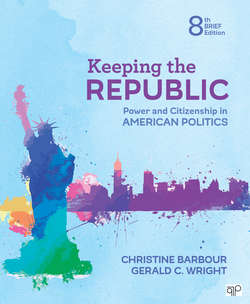Читать книгу Keeping the Republic - Christine Barbour - Страница 167
На сайте Литреса книга снята с продажи.
Reproductive Rights
ОглавлениеThroughout the 1940s, people had tried to challenge state laws that made it a crime to use birth control, or even to give out information about how to prevent pregnancies. The Supreme Court routinely refused to hear these cases until the 1965 case of Griswold v. Connecticut challenged a Connecticut law making it illegal to use contraceptive devices or to distribute information about them. The Court held that, although the right to privacy is not explicit in the Constitution, a number of other rights, notably those in Amendments One, Three, Four, Five, and Nine, create a “zone of privacy” in which lie marriage and the decision to use contraception. It said that the specific guarantees in the Bill of Rights have “penumbras,” or outlying shadowy areas, in which can be found a right to privacy. The Fourteenth Amendment applies that right to the states, and so Connecticut’s law was unconstitutional.95
Because of the Court’s insistence that reproductive matters are not the concern of the government, abortion rights advocates saw an opportunity to use the Griswold ruling to strike down state laws prohibiting or limiting abortion. The Court had tried to avoid ruling on the abortion issue, but by 1973 it had become hard to escape. In Roe v. Wade, the justices held that the right to privacy did indeed encompass the right to abortion. It tried to balance a woman’s right to privacy in reproductive matters with the state’s interest in protecting human life, however, by treating the three trimesters of pregnancy differently. In the first three months of pregnancy, it held, there can be no compelling state interest that offsets a woman’s privacy rights. In the second three months, the state can regulate access to abortions if it does so reasonably. In the last trimester, the state’s interest becomes far more compelling, and a state can limit or even prohibit abortions as long as the mother’s life is not in danger.96 The Roe decision launched the United States into an intense and divisive battle over abortion. States continued to try to limit abortions by requiring the consent of husbands or parents, by outlawing clinic advertising, by imposing waiting periods, and by erecting other roadblocks. The Court struck down most of these efforts, at least until 1977, when it allowed some state limitations. But the battle was not confined to statehouses. Congress, having failed to pass a constitutional amendment banning abortions, passed over thirty laws restricting access to abortions in various ways. For instance, it limited federal funding for abortions through Medicaid, a move the Supreme Court upheld in 1980.97 Presidents got into the fray as well. President Reagan and the first President Bush were staunch opponents of Roe and worked hard to get it overturned. Reagan appointed only anti-abortion judges to federal courts, and his administration was active in pushing litigation that would challenge Roe.
The balance on the Supreme Court was crucial. Roe had been decided by a seven-to-two vote, but many in the majority were facing retirement. When Burger retired, Reagan elevated William Rehnquist, one of the two dissenters, to chief justice, and appointed conservative Antonin Scalia in his place. Reagan’s appointees did finally turn the Court in a more conservative direction, but even they were not willing to completely overturn Roe, though it has been limited in some respects, including a 2007 decision by the Roberts Court that upheld a ban on partial-birth abortion.98 In any case, the debate over reproductive rights in this country is certainly not over. Indeed, all the vitriolic debate that surrounded the 2014 Hobby Lobby case shows that even the idea that contraception use is entirely a matter of private conscience is not wholly settled.99 And the Court’s decision in that case that corporations, too, may have a private conscience muddies the water considerably for the privacy rights of individuals.
Rejection of the notion that there is a constitutional right to privacy has long been a rallying point for the Christian Right, which has become a powerful part of the Republican Party. And although some Democrats also oppose abortion rights, abortion has become largely a partisan issue. Since 1980 the Republicans have included a commitment to a constitutional amendment banning abortion in their presidential party platform. Unable to effect change at a national level, many have directed their efforts to the states. One strategy, pursued by right-to-life groups in Colorado, Mississippi, Oklahoma, and others, is the attempt to pass personhood amendments that would define life as beginning from the moment of conception, creating a legal person possessing citizenship rights. Such amendments would have the effect of making not just abortion illegal, but also, opponents fear, some forms of birth control and the disposal of fertilized eggs after in vitro fertilization processes.100 A number of state legislatures have focused on making abortions harder to obtain, or more emotionally difficult for women (for instance, by requiring them to view an ultrasound of the fetus).101 In 2016 the Supreme Court struck down a Texas law that reduced the number of abortion providers in the state, because it placed an undue burden on the right to an abortion, making it likely that other state restrictions will fall as well.102
